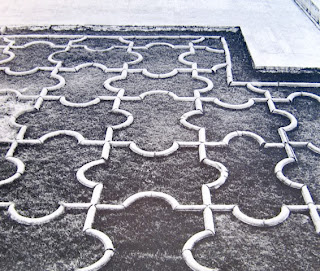 |
| 'Rory' Cameron, child of the Golden Riviera, at his writing desk. |
Browsing design blogs is a favorite pastime. Topics range all over the place but I like best those bloggers who have a strong sense of the history of design and the cavalcade of personalities, eccentrics and trendsetters who make this history so entertaining. Well-known and influential designers all had influences of their own to start with; tracking down their inspiration is as interesting as looking at the results of their work.
The personal contacts and relationships of famous designers and their personal history often reveals many influences on their taste. Remember, taste is made, not born. Creating a personal style that resonates with people takes innate talent, but taste is formed out of influences and observation and education.
As I was reading the early chapters of David Hicks: A Life of Design by his son, Ashley, I was taking note of the early acquaintances and encounters of Hicks with the fashionable and wealthy. The author frequently mentions houses and design influences that formed Hicks' taste in those early years. Most of these names and places are obscure references to most of us today, though in their time they would have been as recognizable to magazine readers of that time as the latest World of Interiors cast of characters will be to avid fans today.
I made a list of Hicks' known influences, past friendships, acquaintances, and blogged many of them. One reference stood out in my list for several reasons. Roderick, or Rory, Cameron was an aesthete, a writer and more honestly, an amateur and dilettante whose inherited wealth and social position, and nearly lifelong residence on the French Riviera, placed him in an ideal position to be acquainted with and observe the fashionable and famous from his childhood in the 1920s till his death in 1970s. Rory had one advantage over most of the faded glories of that dead and gone era. He wrote and published some obscure volumes which are a blend of autobiography, memoir, aesthetic treatises, and travelogue. His books are often unfocused and reveal much about his own snobbery and seem a bit too eager to reveal his connections (translation: name dropping) and his own self-determined social status. This makes him a fun read if you enjoy sitting down with a book of little redeeming value other than it's pen portraits of the rich and famous of a bygone era along with detailed information about their homes, their possessions, their pleasures.
Don't expect salacious gossip. Rory is circumspectly silent about the private lives of his subjects. He writes many pages about Maugham and his "secretary" but only from the perspective of a guest at Maugham's Riviera retreat. The homosexual relationships of many of Roderick's set are not explicitly stated but neither are they denied. They are, rather, taken for granted and not dwelt upon at all.
His best book in this vein is The Golden Riviera (London: Weidenfeld & Nicolson, 1975). It is chock full of amusing portraits of high society and chocked even fuller of endless descriptions of the decor of restaurants favored by the rich, parties attended, and elaborate tours of their homes and possessions.
Rory Cameron is no stranger to blogdom. He is mentioned in connection with many mid-twentieth century tastemakers, but few bloggers seem to have delved much into his personality and writings. La Fiorentina, his mother's Riviera mansion where he spent much of his early and mid-life, is well-known and still famous today as landmark of high Riviera style and fashion.
 |
| La Fiorentina |
 |
| Early decor |
 |
| Redone by Billy Baldwin |
 |
| One of the first "horizon pools" |
 |
| Add caption |
 |
| La Fiorentina's "whole raison d'etre is the position, its gardens reaching right down to the rocks and heaving Mediterranean." |
Garbo, the Lunts, Daisy Fellowes, Graham Sutherland, Somerset Maugham, the usual litany of Riviera residents and visitors. The focal point of this garden..."the view most often reproduced in the different gardening books--are the great shallow grass steps leading down to the sea."
 |
| Library at La Fiorentina |
 |
| Rory Cameron's retreat at Menerbes, his last house in France, its terrace had a spectacular inland view. |








Thanks! I read everything I can find on Rory Cameron & never get tired of looking at photos of his homes.
ReplyDeleteI recently re-read his book on the Pacific, "The Golden Haze", along with the Alistair McClean biographpy of Captain Cook. Roderick Cameron was much better on Cook with more detail, and both books have wonderful ethnographic illustrations. As I used to do museum work in Exeter, England and even cleaned a Maori club collected by Cook, I did enjoy getting these books down from the shelf again and reivisiting them, as well as the Bounty mutiny, a great and moving true yarn.
ReplyDeleteYou have stated that Rory Cameron died in the 70's which is incorrect ~ in fact Cameron died of AIDS related illnesses at his home in Menerbes, France, on 18 September 1985. I had the pleasure of meeting him in South of France 1981. He was a fine and very talented gentleman.
ReplyDelete